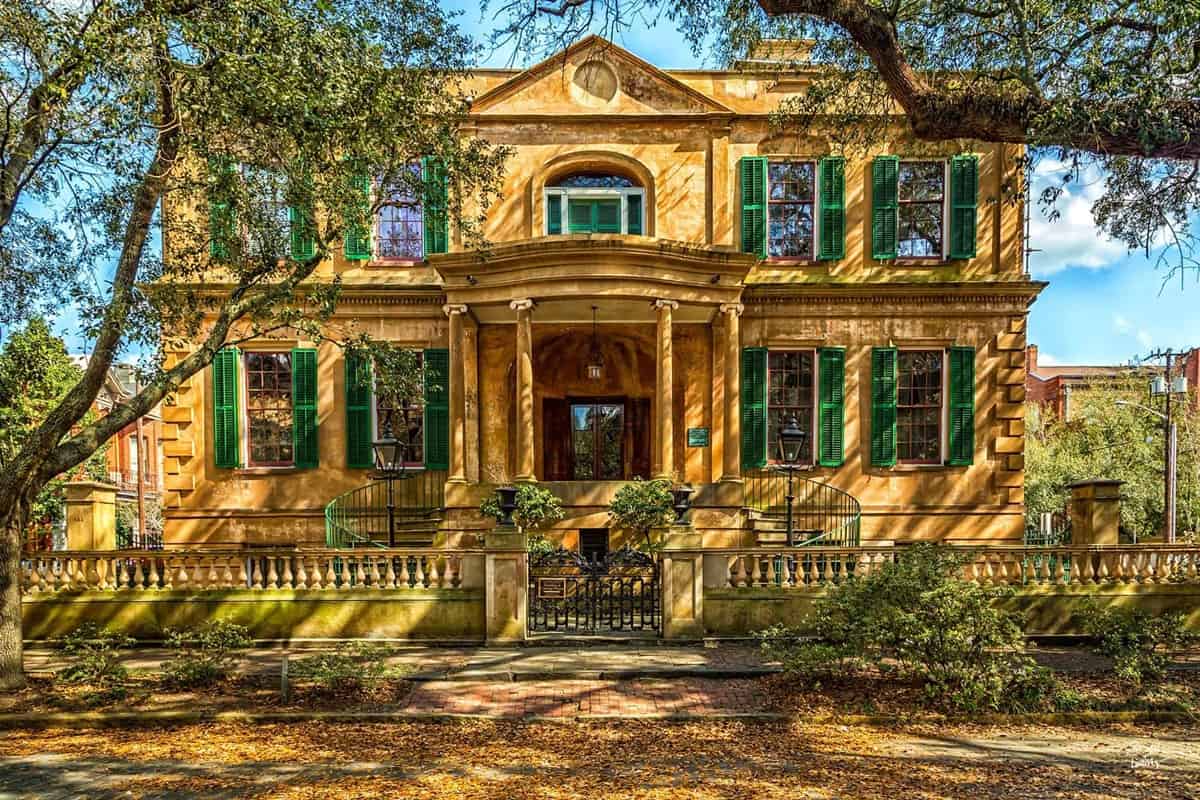
Savannah TourPass
Just show your pass! Pay $0 with a TourPass
Built as a beautiful Regency style mansion in 1819, the Owens-Thomas House, along with its adjacent gardens, carriage house, and slave quarters, allows visitors to explore the complicated relationships between the most and least powerful people in the city of Savannah in the early 19th century.
History of the Richardson-Owens-Thomas House
In November 1816, work began on the new home of banker, shipping merchant, and slave trader Richard Richardson and his wife, Frances. The home was designed by English architect (and relative to Richardson by marriage) William Jay, but was constructed by builder John Retan and the team of free and enslaved men in his charge. The site also included a two-sided privy and a building located on the east end of the lot, which was divided into a carriage house and slave quarters.
The Richardsons moved into the home with their six children and nine enslaved men, women, and children in January 1819. Unfortunately for the Richardsons, the next three years saw steady decreases in their prosperity, including the financial Panic of 1819, a yellow fever epidemic, a fire that destroyed half the city, and the death of Frances and two of the children. By 1822, Richardson decided to sell the house and move to Louisiana, where he had family and business interests. He had been shipping enslaved people, mostly children, from Savannah to New Orleans for years.
By 1824, the Bank of the United States owned the house, which they leased to Mary Maxwell as a boarding house. The Marquis de Lafayette was a guest of Mrs. Maxwell when he visited Savannah in March 1825 as part of his whirlwind tour of the United States for the 50th anniversary of the American Revolution.
In 1830, George Welshman Owens, then mayor of Savannah, purchased the property at auction for $10,000. Owens, who was also a lawyer, planter, and politician, moved in with his wife, Sarah, and their six children in 1833. Over the years, Owens kept nine to 15 enslaved people on the property and held almost 400 men, women, and children in bondage on his plantations.
The last Owens descendant to live in the home was George Owens’ granddaughter, Margaret Gray Thomas. When Thomas passed away in 1951 with no direct heirs, she willed the house to the Telfair Academy of Arts and Sciences to be run as a house museum in honor of her grandfather, George Owens, and her father, Dr. James Gray Thomas. The site opened to the public in 1954.
Carriage House
Orientation Gallery
The south half of this building originally housed horses and carriages on the first floor with a hay loft on the floor above. Beginning in;November 2018, the first level of this building will house our Orientation Gallery. Exhibits in this space help put the story of the site into the larger context of local, regional, and national history. The site of the original hay loft now houses The Loft, a workspace for Telfair’s historical interpreters to study primary documents, examine archaeological artifacts, and research our sites’ history.
Slave Quarters
The north half of the building contains the original slave quarters for the site. This two-story structure was composed of three rooms on each level. Nine to 15 enslaved people, about half of whom were children, lived and worked on the site at any given time between 1819 and the end of the Civil War. Once the war ended, the space became servants’ quarters, housing many of the same people.
Now these these wonderfully preserved spaces offer new interactive exhibits to help visitors understand the day-to-day lives of the enslaved people who lived and worked in the space, as well as the most unique architectural feature of the house, the indoor plumbing.
Holiday Closures:
Nearest Parking Garage: 100 East State Street, Savannah GA.
Hop On/Off Trolley: Stop #8 via Old Savannah Tours
See map below for address
The Tour Pass for Charleston was so easy to use to get into all the attractions on the list and customer service was quick to respond and very kind. I would definitely purchase again!
Bought the Tour Pass for Charlestown, SC. Besides food I didn’t spend money on anything else— I was able to take Horse-drawn tours- Boat tours and countless free entries to museums, Aquarium etc. I was even telling the Uber Drivers about it so they could pass the info to other tourists!
We purchased the 2 day tour for Charleston and were so glad we did! The 3 premium tours we picked were excellent and we had fun adding the standard tours where we could fit them in. An excellent value. I would highly recommend it.
I was just scrolling on facebook when an add jumped out at me. I was planning a trip to Savannah and trying to figure out what all to do while my family was there. TourPass was a great find because you pay one time and can do multiple things in a day. They have so many options and many of them are must see/do tours so it worked out great. We really enjoyed all the tours we booked through TourPass and the app was very easy to use. I would definitely recommend using it if you’re traveling to any of the cities there are in.
We did three tours, the hop on hop off trolley tour, the guided riverboat ride and the haunted pub crawl. All were easy to find, had great narrators/tour guides and were just a lot of fun. We will definitely return soon!
The horse drawn carriage tour of Charleston was a fantastic experience, our guide Ian along with his sidekick Chester did a wonderful job! We would highly suggest this tour!!
The kayaking experience was a different in that there was not a calming experience through the Marina, you had to jockey around boats and fisherman lines heading out into open water, it was quite busy with both of those issues. This tour was okay.
Great way to see the town! One pass with sooo many options. We went on our favorite tour with this pass. Savannah Port Tour! We got to see so much in a day. Easy to use as well. We had no problems checking into any tour or house. Another good thing about the pass…. Not sure we would have known about all these options without the pass! Many thanks!
I purchased the Tour Pass for two people for 2 days. We started early each day and tried to experience as many opportunities as we could. Using it was super easy and we saved money over the individual admission prices. I highly recommend!
This pass was great. I was able to take multiple tours and they were all included in the price. I will defiantly use this option again when traveling.
We got the 4 day pass and spent 1 full week in Charelston. We scheduled 4 featured tours for each night/day and filled in the rest of the time with the amazing standard tours. It made our stay a great time. I recommend this pass.
We live in Jacksonville and regularly in St. Augustine for day trips or long weekends. Tour Pass was fantastic to use during a recent long weekend visit. We booked the two-day pass to take advantage of our favorite attractions with the added benefit of trying some new things we had not visited in the MANY trips to the Old City. Unfortunately, a hurricane forced the closure of many attractions in the middle of the day on Day 2 but an email to Tour Pass was quickly responded to and offered a great solution. We loved the opportunity to revisit some attractions we had seen before and were excited to experience some for the first time. We could squeeze in quite a few in the one and a half days . We were looking forward to using Tour Pass on our next visit to Savannah!
The tour pass was awesome! We had so much to do and it was very easy and convenient to use. Definitely worth purchasing. You really end up saving money. I wish they would have more than three days max. I would definitely purchase more days. It was a wonderful trip!
Tour guide was very knowledgeable! Pass was a great savings and allowed us to do a lot more things.
Tour Pass was very convenient. Places had my name when I arrived. Didn't have to buy tickets
Just showed my passed and I was in. Got alot for the money. I bought 3 day pass. Used it those 3 days in Charleston.
Me and my besties took advantage of the one day pass! Wow did we get our money’s worth! We didn’t get to do everything, but out of the stops we did visit, really worth the price!! I def recommend! Probs would do it again too!! Ha! Loved it, and such a great time visiting St. Auggie! ;)

Pass purchases can be refunded (minus 3% credit card processing fees) if requested within thirty-days of purchase date (for unused passes). Optional Trip Insurance can be purchased for a nominal fee at checkout which extends the refund period up to one-year from purchase date. Conditions apply. View full refund policy by clicking button below.